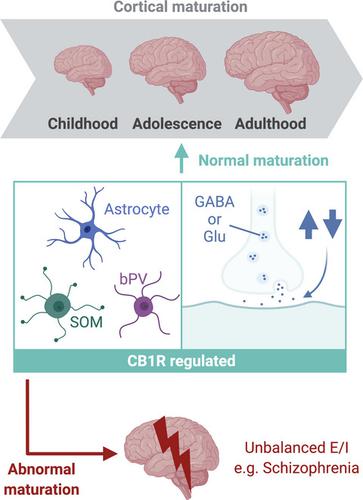当前位置:
X-MOL 学术
›
Eur. J. Nerosci.
›
论文详情
Our official English website, www.x-mol.net, welcomes your feedback! (Note: you will need to create a separate account there.)
Endocannabinoids and cortical plasticity: CB1R as a possible regulator of the excitation/inhibition balance in health and disease
European Journal of Neroscience ( IF 3.4 ) Pub Date : 2021-01-11 , DOI: 10.1111/ejn.15110 Lucas J A Durieux 1, 2 , Sara R J Gilissen 1, 2 , Lutgarde Arckens 1, 2
European Journal of Neroscience ( IF 3.4 ) Pub Date : 2021-01-11 , DOI: 10.1111/ejn.15110 Lucas J A Durieux 1, 2 , Sara R J Gilissen 1, 2 , Lutgarde Arckens 1, 2
Affiliation

|
The endocannabinoid system has been linked to neurological disorders in which the excitation inhibition (E/I) balance in the neocortex is dysregulated, such as schizophrenia. The main endocannabinoid receptor type 1 of the central nervous system—CB1R—is expressed on different cell types, that when activated, modulate the cortical E/I balance. Here we review how CB1R signalling contributes to phases of heightened plasticity of the neocortex. We review the major role of the CB1R in cortical plasticity throughout life, including the early life sensory critical periods, the later maturation phase of the association cortex in adolescence, and the adult phase of sensory deprivation-induced cortical plasticity. Endocannabinoid-mediated long-term potentiation and depression of synapse strength fine-tune the E/I balance in visual, somatosensory and association areas. We emphasize how a distinct set of key endocannabinoid-regulated elements such as GABA and glutamate release, basket parvalbumin interneurons, somatostatin interneurons and astrocytes, are essential for normal cortical plasticity and dysregulated in schizophrenia. Even though a lot of data has been gathered, mechanistic knowledge about the exact CB1R-based modulation of excitation and/or inhibition is still lacking depending on cortical area and maturation phase in life. We emphasize the importance of creating such detailed knowledge for a better comprehension of what underlies the dysregulation of the neocortex in schizophrenic patients in adulthood. We propose that taking age, brain area and cell type into consideration when modulating the cortical E/I imbalance via cannabinoid-based pharmacology may pave the way for better patient care.
中文翻译:

内源性大麻素和皮质可塑性:CB1R 作为健康和疾病中兴奋/抑制平衡的可能调节剂
内源性大麻素系统与新皮质中的兴奋抑制 (E/I) 平衡失调的神经系统疾病有关,例如精神分裂症。中枢神经系统的主要内源性大麻素受体 1 型 - CB1R - 在不同的细胞类型上表达,当它们被激活时,调节皮质 E/I 平衡。在这里,我们回顾了 CB1R 信号如何促进新皮层可塑性增强的阶段。我们回顾了 CB1R 在整个生命过程中皮层可塑性中的主要作用,包括生命早期的感觉关键期、青春期联合皮层的后期成熟阶段以及感觉剥夺诱导的皮层可塑性的成人阶段。内源性大麻素介导的突触强度的长期增强和抑制微调视觉中的 E/I 平衡,体感和联想区域。我们强调一组独特的关键内源性大麻素调节元素,如 GABA 和谷氨酸释放、篮子小白蛋白中间神经元、生长抑素中间神经元和星形胶质细胞,对于精神分裂症的正常皮质可塑性和失调是必不可少的。尽管已经收集了大量数据,但仍然缺乏关于基于 CB1R 的确切兴奋和/或抑制调制的机制知识,具体取决于生命中的皮质区域和成熟阶段。我们强调创造如此详细的知识对于更好地理解成年精神分裂症患者新皮质失调的基础的重要性。我们建议考虑年龄,
更新日期:2021-01-11
中文翻译:

内源性大麻素和皮质可塑性:CB1R 作为健康和疾病中兴奋/抑制平衡的可能调节剂
内源性大麻素系统与新皮质中的兴奋抑制 (E/I) 平衡失调的神经系统疾病有关,例如精神分裂症。中枢神经系统的主要内源性大麻素受体 1 型 - CB1R - 在不同的细胞类型上表达,当它们被激活时,调节皮质 E/I 平衡。在这里,我们回顾了 CB1R 信号如何促进新皮层可塑性增强的阶段。我们回顾了 CB1R 在整个生命过程中皮层可塑性中的主要作用,包括生命早期的感觉关键期、青春期联合皮层的后期成熟阶段以及感觉剥夺诱导的皮层可塑性的成人阶段。内源性大麻素介导的突触强度的长期增强和抑制微调视觉中的 E/I 平衡,体感和联想区域。我们强调一组独特的关键内源性大麻素调节元素,如 GABA 和谷氨酸释放、篮子小白蛋白中间神经元、生长抑素中间神经元和星形胶质细胞,对于精神分裂症的正常皮质可塑性和失调是必不可少的。尽管已经收集了大量数据,但仍然缺乏关于基于 CB1R 的确切兴奋和/或抑制调制的机制知识,具体取决于生命中的皮质区域和成熟阶段。我们强调创造如此详细的知识对于更好地理解成年精神分裂症患者新皮质失调的基础的重要性。我们建议考虑年龄,



























 京公网安备 11010802027423号
京公网安备 11010802027423号